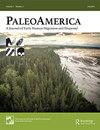阿根廷布宜诺斯艾利斯东坦蒂利亚更新世/全新世过渡时期新考古遗址(Cueva Alí mustaf, ~ 12,000 calyr BP)的石器技术分析
IF 1.7
Q1 ANTHROPOLOGY
引用次数: 2
摘要
摘要本文介绍并讨论了位于坦迪利亚山脉东部(阿根廷布宜诺斯艾利斯)的新发现考古遗址Cueva AlíMustafá的石器组合分析。与几个壁炉和散落的木炭碎片有关的石像文物的年代为10450年 ± 38和9032 ± 分别是30年前的放射性碳。该遗址被解释为一个短暂占用的营地,在那里进行了与石器制造的后期和最终阶段有关的石器挖掘活动。发现了来自不同来源的各种各样的石器原材料的使用,最常见的是两种沉积岩,其中一种是来源于距离考古遗址100多公里的细粒岩石,另一种是当地可获得的中粒岩石。其他岩石的识别频率较低,值得注意的是,包括500多公里外的硅化石灰岩。本文章由计算机程序翻译,如有差异,请以英文原文为准。
Lithic Technological Analysis of a New Archaeological Site (Cueva Alí Mustafá, ∼12,000 cal yr BP) of the Pleistocene/Holocene Transition in Eastern Tandilia, Buenos Aires, Argentina
ABSTRACT This paper presents and discusses the analysis of the lithic assemblage from a newly discovered archaeological site, Cueva Alí Mustafá, located in the eastern sector of the Tandilia Range (Buenos Aires, Argentina). Lithic artifacts associated with several hearths and scattered fragments of charcoal were dated in 10,450 ± 38 and 9032 ± 30 radiocarbon years ago, respectively. The site is interpreted as an ephemerally occupied camp in which lithic knapping activities were carried out, related to the late and final stages of stone-tool manufacture. The use of a wide variety of lithic raw materials from different sources was identified, most frequently two sedimentary varieties, one of which is a fine-grained rock whose source is more than 100 km from the archaeological site, and another, a medium-grained rock that is locally available. Other rocks were identified in lower frequencies, including, remarkably, the presence of silicified limestone which can be traced to more than 500 km away.
求助全文
通过发布文献求助,成功后即可免费获取论文全文。
去求助
来源期刊

PaleoAmerica
Earth and Planetary Sciences-Paleontology
CiteScore
3.70
自引率
0.00%
发文量
15
期刊介绍:
PaleoAmerica disseminates new research results and ideas about early human dispersal and migrations, with a particular focus on the Americas. It fosters an interdisciplinary dialog between archaeologists, geneticists and other scientists investigating the dispersal of modern humans during the late Pleistocene. The journal has three goals: First and foremost, the journal is a vehicle for the presentation of new research results. Second, it includes editorials on special topics written by leaders in the field. Third, the journal solicits essays covering current debates in the field, the state of research in relevant disciplines, and summaries of new research findings in a particular region, for example Beringia, the Eastern Seaboard or the Southern Cone of South America. Although the journal’s focus is the peopling of the Americas, editorials and research essays also highlight the investigation of early human colonization of empty lands in other areas of the world. As techniques are developing so rapidly, work in other regions can be very relevant to the Americas, so the journal will publish research relating to other regions which has relevance to research on the Americas.
 求助内容:
求助内容: 应助结果提醒方式:
应助结果提醒方式:


